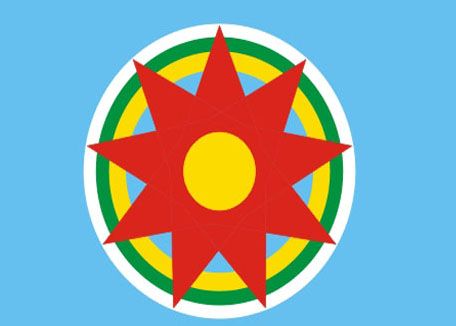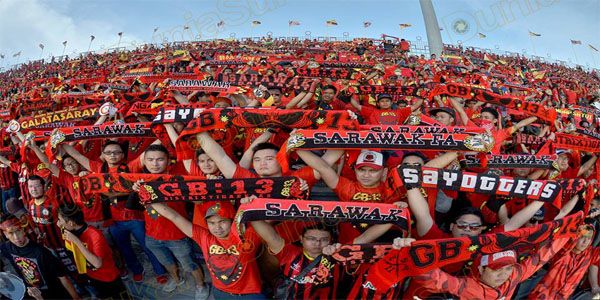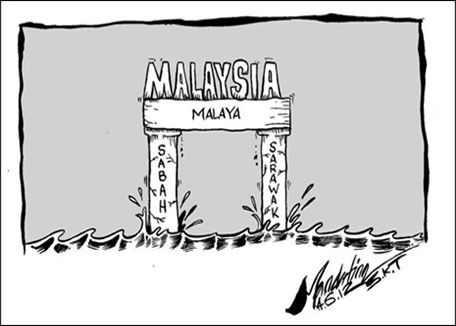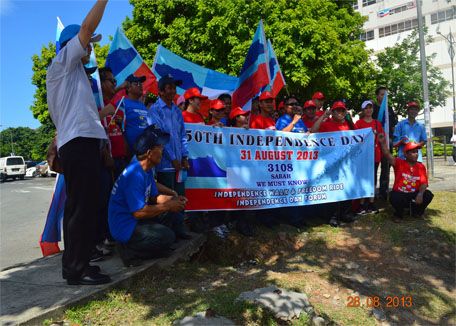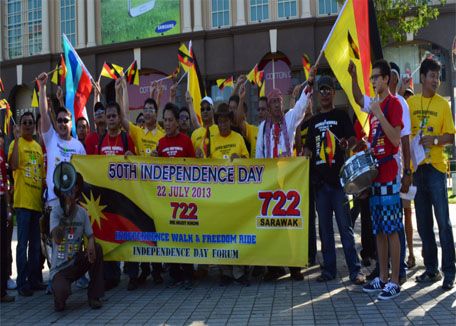 |
| Tan Sri Simon Sipaun (Pesuruhjaya Suhakam 2008-2010) |
More than 20 years ago when I was still a civil servant, a gentleman came to see me. At the time he had just retired. He was a Sabahan and the substantive holder of the post of Director of the National Registration Department in Sabah.
However he was never given the opportunity to function as a director. Instead he was posted to Semenanjung. He was neither a Malay nor a Muslim. He told me that genuine identity cards were prepared in the headquarters and brought to Sabah to be given to Muslim illegal immigrants. There was a special unit to handle this.
It is people like him who should be of interest to the on-going RCI in its effort to establish the real truth concerning the illegal immigrant issue. Genuine Sabahans are keen to know the whole truth and nothing but the truth.
It is appropriate that the RCI has requested ex-civil servants who had first-hand experience and knowledge from inside the relevant government departments and agencies to appear before it. I hope that people from Sabah who have done research, written books and articles on the issues and problems associated with illegal immigrants will also be invited to testify. Some of them have also been detained under the ISA. The information disclosed by witnesses so far is quite shocking but not surprising.
It is shocking because the government appears to be uncaring towards Malaysians living in Sabah preferring non-citizens over citizens. It is not surprising because it is what the people of Sabah had suspected all along. I note some of the ex-civil servants who had testified had been detained under the ISA yet they were only carrying out the directives of their political masters. Why were they detained unless, of course, they were made the unfortunate scapegoats?
The Minister of Home Affairs allegedly made a statement that the government has neither issued citizenship nor given voting rights to illegal immigrants in Sabah. He wanted proof from people who thought otherwise. On 1 October, 2011, the Deputy Home Minister Lee Chee Leong was reported to have denied that Sabah is a victim of ‘projek IC’ – a planned illegal immigrant population explosion engineered by the federal government for citizenships in exchange for votes to help the present government retain political power. YB Datuk Wilfred Bumburing took up the challenge of the Home Minister. YB Datuk Wilfred can relate the rest of the story as he knows best.
In the early 70s a lot of Vietnamese refugees landed in Semenanjung. They were confined to Pulau Bidong and within 2 years they were all moved to other countries. They were not Muslims. There appears to be a double standard. One standard for the non-Muslim Vietnamese and one for the Muslim illegal immigrants in Sabah.
Malaysia is neither a state party to the UN Convention Relating to the Status of Refugees 1951 nor the 1967 Protocol. This being the case, all refugees in Malaysia are treated as illegal immigrants. They are subjected to penalties, detention and deportation under the Immigration Act 1959/63. This Act does not recognize refugees.
To indicate that the Federal Government is seen to be doing something to resolve the mother of all problems in Sabah, a Federal Task Force was established more than 25 years ago. But it took one year just to create the post of the head of the task force. Today, the task force is still in existence, but so is the problem, only bigger and more complicated.
I do not blame the illegal immigrants for being in Sabah. As human beings they are just looking for a better life. They have human rights like any Malaysian, no more no less. Human rights have no borders. However, I question the authorities for allowing them into Sabah without proper documents and move around in Sabah with impunity.
The rapidly increasing number of illegal immigrants is fast changing the economic, social, cultural and political landscape of the state. The reverse takeover has long started. It appears that the government has no intention of resolving the problems once and for all because the government appears to be part of the problem rather than the solution. This is indicated by the terms of reference of the RCI which are by and large investigative in nature. The terms of reference should include identifying who are the real culprits followed by the prosecution. I hope the RCI will interpret its mandate liberally.
Foreigners who were not qualified to be given citizenship status or given the right to vote illegally should have their citizenship revoked and deported to their country of origin. However, I fear that there will not be any political will to resolve the issue as it appears that it is part of the present government agenda. If not, this problem should not arise today.
The demand by genuine Sabahans for the formation of an RCI is not new. Much earlier 100,000 signatures had been collected requesting government to establish an RCI. It was followed by a long period of silence. It was not until 8 February, 2012 that a decision was made for the formation of the RCI.
At the time its terms of reference were not known. To arrive at a decision on its establishment without the terms of reference is like putting the cart before the horse. Many people are of the view that if it was not for the impending 13th general election, it is very conceivable that the RCI would not have been established.
Malaysians living in Sabah feel very uneasy, threatened and insecure as the number of foreigners keeps increasing. You may remember the demonstrations that took place in March, 1986. My office at the time was over-looking the state mosque and I could see hundreds of them gathering outside the mosque before they took to the streets. The only Sabahans I noticed were a few prominent political leaders from berjaya and usno leading them. The illegal immigrants were being made use of. I heard explosions all over town.
A number of vehicles were either over-turned or burnt. It was very frightening. If my memory does not fail me, I think at least five people lost their lives. Sabah people will not do this sort of thing. I could not believe that such incidents could take place in Sabah. It was sad and reflected very badly on the mindset and maturity of the leaders who had a hand in instigating the illegal immigrants to demonstrate and causing unnecessary fear among the peace loving public.
When kg. Ice-box in Tawau was burnt about 25 years ago 5000 people lost their houses. Of the 5000, only 500 were Malaysians. The late general Zulkifli told me he saw many of them coming out with M16 in their possession.
In 1970, Sarawak population was about 1 million. In 2004, 34 years later, it was about 2 million. In 1970, Sabah’s population was about 698,000. In 2004, it was estimated to be between 3.3 and 3.5 million. Based on Sarawak’s population growth rate Sabah’s population in 2004 should be around 1.4 million. There is a ‘surplus’ of 1.9 million.
As of June 2005 the district of Kinabatangan had a population of about 85,000 and only about 25,000 were Malaysians. As at 23 December, 2005 Sabah’s prison population was 3052. About 70% were foreigners. In KK we have a Filipino market. In kg. Boronuon behind Telipok town you can see thousands of them. Next to it is a completed housing development.
The last time I saw the place, not a single unit has been taken up. The Minister of Health was reported in the Daily Express in its 9 July, 2006 edition that hospitals in Sabah were receiving the most number of foreigners amounting to about 30%. According to the Minister, some of them used forged identity cards to gain admission and leave without paying. They also account for many cases of contagious and communicable diseases. It was reported in the Daily Express on 18 November, 2007 that 80% of the Likas maternity hospital beds were occupied by illegal immigrants.
It is ironical that whilst thousands of illegal immigrants have become citizens and voters, many locals especially those living in remote areas have no valid documents such as birth certificates and mykad. Technically they are stateless and yet they have never left the place of their birth. It has been said that what is impossible elsewhere is possible in Sabah.
Some of you may recall a news report in 2002 regarding an immigration raid in Keningau. 34 foreigners were found to be in possession of mykad. At the time mykad had not yet been introduced in Sabah. The National Registration Department confirmed that the cards were indeed genuine. How could this happen without the complicity of the relevant authorities?
It is common knowledge that the electoral roll in Sabah is highly tainted. The new Sabah Times in its 9 June, 2001 edition reported that the High Court ordered former CM Datuk Yong Teck Lee to vacate his Likas seat because he won it in 1999 with the help of phantom voters. Justice Datuk Muhammad Kamil Awang said that the 1998 electoral roll for the constituency was illegal and the election held in March 1999 was null and void. The judge, amongst others, stated that the evidence adduced was tip of an iceberg and fantastic evidence.
The next logical step would have been to clean the electoral roll. Instead, Parliament amended the Election Act, whereby the electoral roll once gazetted cannot be challenged in any court of law. This is just not right. A clean electoral roll represents a universal democratic value. Immediate action should be taken to clean the tainted electoral roll before the 13 general election. If the Election Commission is unable to do it for some reasons it could be farmed out to a suitably qualified, experienced and independent organization.
-----------------------------------
Views shared by Tan Sri Simon Sipaun at the DAP Public Forum on the RCI on Illegal Immigrants in Sabah held on Thursday 24 January, 2013, 2.30 pm – 4.30 pm at the Star City, Kota Kinabalu.
By, Rajah Raqafluz



